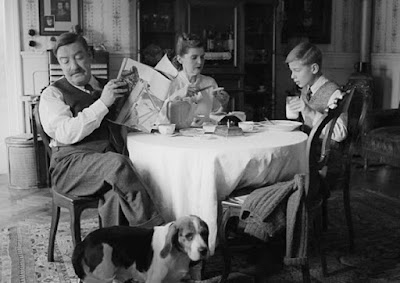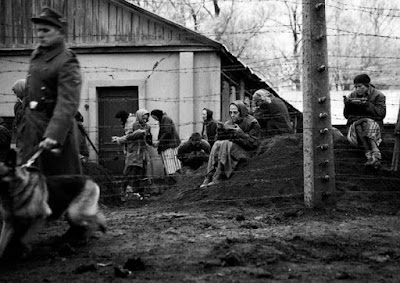“ A real director is not a director that makes films but who understands people. Or, in any case, tries to understand them because understanding people is, of course, impossible”–Andrei Konchalovsky (quote from his official website)
When Andrei Konchalovsky is in his
elements, he can be amazing. His latest
work Paradise is one of his best
works, carefully crafted and entertaining for attentive and astute viewers, a
film in which difficult questions beyond the obvious horrors of the Holocaust
are placed and answered by characters that we can possibly associate in our contemporary
daily life.
Konchalovsky is not a filmmaker to
be ignored or scoffed at—he studied cinema with Andrei Tarkovsky. The two
classmates went on to be co-scriptwriters of Tarkovsky’s first three films The Steamroller and The Violin (1961), Ivan’s Childhood (1962) and Andrei Rublyev (1966). Tarkovsky made a film The First Day (1979), totally based on Konchalovsky’s script, which
ran into problems with political censors of the day and was hidden (and now
believed to be lost) but not actually destroyed as Tarkovsky publicly claimed. A
well-known admirer of Akira Kurosawa, Konchalovsky got the nod of the Japanese
maestro to make the film based on Kurosawa’s original script of Runaway Train, after Kurosawa gave up
on the idea to make a film out of it. Konchalovsky’s Runaway Train (1985) was
made in USA in English language with major Hollywood actors—a profound film
that most viewers dismissed as a mere prison escape film. If one studies Paradise and compares it with Runaway Train, there are interesting
parallels between the two films. More on that, later, in this review. According
to IMDB, Paradise was also partially
shot in USA.
 |
| Interrogation of Olga by Jules, interrupted by a tortured resistance fighter being dragged to another room for further questioning |
What is Paradise all about? Many films have been made on the horrors of the
Holocaust that show the brutality and lack of pity for the prisoners by the
German Nazi militia. Very few works of cinema have looked at the situation from
the point of view of the Germans [a glorious exception being Hans Jurgen
Syberberg’s Hitler--a film from Germany
(1977)] and other nationalities involved closely with the horrors of the Nazi
concentration camps. Paradise is
less about the Jews that perished and more about the mindset and
self-evaluation of three distinct fictional personalities carved out of the Russians,
the Germans and the French communities by co-scriptwriters Elena Kiseleva and
Andrei Konchalovsky on their second feature film together. Their first collaboration The Postman’s White Nights (2014) and
their second Paradise went on to win the Best Director awards at the Venice
film festival in 2014 and again in 2016. Their craft was also recognized by the
Mar del Plata international film festival by honouring it with the Best
Screenplay award. The magic these two individuals
are able to weave are reminiscent of the Kieslowski and Piesiewicz
collaboration in the evening of the famous Polish director’s career.
Kiselava and Konchalovsky, being
Russians, built the tale around Olga, a Russian émigré in Paris, an aristocrat,
and an editor of the Vogue fashion
magazine. The Nazi Germany had occupied Paris and Olga is close to the French
resistance and hides two Jewish kids only to be arrested for the good deed. The
co-scriptwriters then create Jules, a French upper middle class “collaborator,”
a senior police official, who serves the Nazis by identifying the members of
the French resistance using torture and sending off Jews to concentration camps
while leading a comfortable life with his wife and son. Finally, the scriptwriter duo sculpt a well-read,
well-appointed German aristocrat named
Helmut, who admires the Russian works of Chekov and who had once contemplated
doing a thesis on the Russian writer, and yet surprisingly believes in Aryan
superiority concepts of Hitler and Himmler.
 |
| The comfortable family world of Jules in Paris |
The amazing script also sculpts
the contradictions in the three well-to-do characters. The attractive Olga (Yulia Vysotskaya, wife
of director Konchalovsky), who is not a Jewess, offers sex to Jules, her interrogator to avoid
torture and free her friends in the Resistance. Jules (Phillipe Duquesne) who
has no compunction in torturing his own countrymen lives with his wife and son as
respectable Parisian family man. Helmut, (Christian Clauss/Kristian Klauss) who believes in the
extermination of Jews, saves many from being sent to the concentration camps if
they were only a quarter Jew by their family tree and would shoot German
officers to death if found to be corrupt. The lives and death of the fascinating
trio intersect as the film progresses. Olga could have escaped and lived with a
man, who she once knew as a benign cultured person and unfortunately had
transformed into an evil man. She chooses not to escape death by helping
another live in her place.
Add to the interesting trio of
characters developed by the scriptwriters, an interrogation of the trio, each separately done, as if they
themselves are inmates of the concentration camps wearing prisoner outfits by
an interrogator you never see. Yes, Olga
was an inmate. But the other two were not inmates but safe outsiders. These
interrogations are intelligently spliced within the films main narrative. Jules
is shown making statements to his interrogator after the film shows he is
killed. Only the interesting end scene put all what has preceded in the film in
full perspective. That is when you
realize how different and creative the script and direction of Paradise is compared to other popular Holocaust
films such as Schindler’s List and Son of Saul. The master stroke of Paradise is that the interrogator is only heard on screen, never discussed beyond
that for obvious reasons.
 |
| Olga in the concentration camp fighting for a personal bar of soap |
 |
| ...and Olga (extreme right) enjoying her soup after recovering the shoes of a dead inmate to cover her bare feet |
 |
| Olga and Helmut--reality and cinema--enjoying a brief interlude of comfort and love |
Konchalovsky and Kiseleva provide
two parallel ways for the viewer to evaluate the film. One is the obvious
actions of the trio and the resulting feelings for the viewer. The second is
the self assessment of the trio of their actions. The self appraisal transcends
the obvious actions and therefore provides the viewer an opportunity to
contemplate the power of good cinema over the conventional film narrative. In a
larger context, the film assesses the role of three nations in the world war
and the complex attitudes of individuals to the Holocaust.
Konchalovsky, either intentionally
or unintentionally, has developed the tale of Paradise on the basic structure of his earlier Runaway Train. In Runaway
Train, there were two male escapees (Manny/Jon Voight and
Buck/Eric Roberts) and one unwitting
female passenger (Sara/de Mornay). The first two were convicts, while the
innocent third was on the train by happenstance. In Paradise, two men and a woman are being interrogated. The two men have committed war crimes of
different hues, while the woman is essentially a good individual who helped two
Jewish children hide from the Nazis initially and helps two Jewish children and
their mother at the end of the film. In Runaway
Train, the relentless warden does not dispense justice but gets his moral
due. In Paradise, the mysterious
interrogator dispenses justice.
The title Paradise is very interesting as nothing in the film except for the
finale has any relevance to the word. What happens in the film is far from any
concept of paradise. Is it the idyllic Aryan dream that Helmut believed in that
title refers to? Only the last few minutes of the film reveal Konchalovsky’s
key to understanding the film and its purpose to the full extent. Konchalovsky,
like Tarkovsky, is deeply religious and influenced by the Russian Orthodox
Church. There is no overt religious symbol in the entire film and yet it is a
religious film. The end of the film gives the truer meaning of the title. That
is the capability of Konchalovsky who made Jon Voight’s final posture in Runaway Train atop the hurtling train
engine unmistakably religious without a word spoken in the film that was
religious. You learn a lot when you have to bypass censors in Stalinist Russia
that Tarkovsky and Konchalovsky endured.
There is another common strand
between Tarkovsky and Konchalovsky. Both
were born into aristocratic families that gave importance to literature.
Tarkovsky’s father was a poet. Konchalovsky’s family (the Mikhlakovs) can be traced
back to the Grand Duchy of Lithuania and Andrei Konchalovsky is the half bother
of another important Russian filmmaker, Nikita Mikhalkov.
Perhaps this element of aristocracy
has something to do with Konchalovsky’s interest in Chekov and Turgenev, rather
than Dostoevesky or Tolstoy. Two of Konchalovsky’s previous films are
adaptations of the former pair—Uncle Vanya
and The Nest of the Gentry. Helmut’s
character in Paradise, who loves Russian literature, refers more
than once to Chekov rather than Dostoevesky or Tolstoy.
One would be intrigued by the choice
of black and white and the Academy format aspect ratio of 11:8 used in Paradise. These concepts, the static
camera placement during interviews and the recurring suggestion of film rolls
running out has been obviously
introduced to give the feeling of an interrogation where those interviewed have
to tell the truth often from their own volition. All that makes sense, if the
viewer is patient right up to the end and all what had preceded up to that
point falls into place. And what an
ending!
 |
| Olga and the two Jewish kids in the concentration camps-- a throwback to the two kids she tried to save earlier that got her into her current plight |
Paradise is definitely one of the most intelligent films made in
2016 with a remarkable screenplay and three lead actors chosen carefully from
three countries: Russia, Germany and France, to provide veracity few directors care
to indulge in these days.
P.S. Paradise is one of the author’s top 10 films of 2016. Konchalovsky’s Runaway Train (1985) was reviewed earlier on this blog and is one
of the author’s top 100 films. This film, for those interested in Christian theology, provides an interesting insight on the Russian Orthodox Church's view on the concept of purgatory. In that context, note the hair growth on the recently shaven head of the lead actress--a detail that says a lot about the filmmakers. Mr Konchalovsky is also one of the author's 15 favourite active filmmakers
































